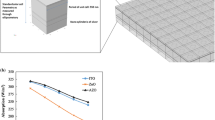Abstract
The performance of ITO films grown by RF sputtering as a transparent conductive oxide (TCO) was evaluated using a photonic flux density figure of merit. This figure of merit provides additional information compared to other figures of merit, since it includes in its analysis the performance along the electromagnetic spectrum comprehended between the TCO bandgap energy and the absorber bandgap energy. The ITO thin films were grown by 200 W power RF sputtering without any substrate heating or post annealing treatment varying the Ar pressure. Instead of heating, the relatively high RF power provided the energy needed to enhance the diffusion process of the sputtered species in the substrate, thus improving crystallinity. Transmittances greater than 85% were obtained in the visible region of the spectrum independently of the argon pressure used. Regarding the electrical resistivity, an average value of 10−3 Ω cm was obtained at 300 K. Photocurrent losses were calculated in order to compare the grown ITO films performance with an ideal one. The photonic flux density figure of merit obtained in this work suggests that the overall performance is sufficient to be implemented as TCOs in many applications; moreover, the lack of substrate heating or post-annealing treatment makes these films good candidates to be used as TCOs in heat sensitive devices such as P3HT:PCBM.





Similar content being viewed by others
References
E. Terzini, P. Thilakan, C. Minarini, Mater. Sci. Eng. B 77, 110 (2000)
K.N. Rao, S. Kashyap, Surf. Rev. Lett. 13, 221 (2006)
M.K. Fung, K.K. Wong, X.Y. Chen, Y.F. Chan, A.M.C. Ng, A.B. Djurišić, W.K. Chan, Curr. Appl. Phys. 12, 697 (2012)
S.S. Yap, T.K. Yong, C.H. Nee, T.Y. Tou, Appl. Laser Ablation-Thin Film Depos. Nanomater. Synth. Surf. Modif. (InTech, 2016)
A.H. Al-hamdani, J. Mater. Sci. Eng. 4, 346 (2014)
T.M. Hammad, Phys. Status Solidi 206, 2128 (2009)
G. Haacke, J. Appl. Phys. 47, 4086 (1976)
J.A. Mendez-Gamboa, R. Castro-Rodriguez, I.V. Perez-Quintana, R.A. Medina-Esquivel, and A. Martel-Arbelo, Thin Solid Films 599, 14 (2016)
O. Tuna, Y. Selamet, G. Aygun, L. Ozyuzer, J. Phys. D Appl. Phys. 43, 55402 (2010)
H. Koseoglu, F. Turkoglu, M. Kurt, M.D. Yaman, F.G. Akca, G. Aygun, L. Ozyuzer, Vacuum 120, 8 (2015)
N.M. Khusayfan, M.M. El-Nahass, Adv. Condens. Matter Phys. (2013). (2013)
S.V.N. Pammi, H.-J. Jung, S.-G. Yoon, IEEE Trans. Nanotechnol. 10, 1059 (2011)
Powder Diffraction File, Joint Committee on Powder Diffraction Standards, (ASTM, Philadelphia, PA, 1967) Card 060416
A.M. Gheidari, F. Behafarid, G. Kavei, M. Kazemzad, Mater. Sci. Eng. B 136, 37 (2007)
H.-N. Cui, V. Teixeira, L.-J. Meng, R. Martins, E. Fortunato, Vacuum 82, 1507 (2008)
G.H. Chandra, J.P. De la Cruz, J. Ventura, Semicond. Sci. Technol. 26, 75017 (2011)
D. Raoufi, F. Hosseinpanahi, J. Mod. Phys. 3, 645 (2012)
J. Tauc, Amorph. Liq. Semicond. (Springer, 1974), pp. 159–220
L. Álvarez-Fraga, F. Jiménez-Villacorta, J. Sánchez-Marcos, A. de Andrés, C. Prieto, Appl. Surf. Sci. 344, 217 (2015)
L.J.A. Koster, V.D. Mihailetchi, P.W.M. Blom, Appl. Phys. Lett. 88, 93511 (2006)
H.H. Yudar, Ş Korkmaz, S. Özen, V. Şenay, S. Pat, Appl. Phys. A 122, 748 (2016)
M.H. Ahn, E.S. Cho, S.J. Kwon, Vacuum 101, 221 (2014)
Acknowledgements
The authors acknowledge the financial support by Conacyt Postgraduate Scholarship. The authors also thank Patricia Quintana for the access to LANNBIO, Daniel Aguilar Treviño for his technical assistance in X-ray diffraction measurements, and M.C. Willian Cauich for his technical assistance in film thicknesses measurements. This work has been supported by CONACYT-SENER under contract 254667.
Author information
Authors and Affiliations
Corresponding author
Rights and permissions
About this article
Cite this article
Reyes, D.C., Mendez-Gamboa, J.A., Vidal, M.R. et al. Room-temperature ITO electrodes evaluated for organic solar cells using a photonic flux density figure of merit. J Mater Sci: Mater Electron 29, 11059–11064 (2018). https://doi.org/10.1007/s10854-018-9188-8
Received:
Accepted:
Published:
Issue Date:
DOI: https://doi.org/10.1007/s10854-018-9188-8




